Please consider one more thing this morning May 29 and the year is, 2018. As most would not logic the navigation to around the world, this is the Viking approach to a best comprehension, not in force of understanding rather the logic of consideration.
Religion has been bound by the hems by many civilizations. The fact that generally people at large mass practice such things it is the aspect by design when other (People, Civilizations) i.e. societies send people to the trade roads. Upon such the natural landing would entice complete attraction to the foreigner. Now, present attraction as both good and bad, threatening and beneficial before you desire only the groin. To process in gentle appeal it is the mind, i.e. brain that electricity begins to spark more, each of you reading will have different immediate act to reactors therefore calm before the storm will not exactly calculate so I beg you to now consider the saying "Sticks and stones can break my bones but words will never hurt me" as a basis to ground the year, a reminder, it is 2018.
According to the census: "National census conducted in 2007, over 32 million people or 43.5% were reported to be Ethiopian Orthodox Christians, over 25 million or 33.9% were reported to be Muslim, 13,7 million, or 12.6%, were Protestant, and just under two million or 2.6% adhered to traditional beliefs" (https://en.wikipedia.org/wiki/Religion_in_Ethiopia). This is for the Country of Ethiopia and what I will say next will cause a reaction, one way or another the reaction will be based on your understanding or your condemnation thereof. Please be patient as Ethiopia is a very old country and their continent has nothing to do with this conversation.
Often two people get together and make a baby. A person of Islam and a person of Catholic get together on the what we would even know as a familiar word today and while 'proselytizing' nature becomes the habit of it's construction. Circumstance? What is attraction? How would you grace the appeal of yourself vs. your basic need to love? It is the grace of just the Grand Canyon that would Niagara these falls as love is in the water of life and rib is in the what?
Synopsis: An Islam and a Catholic equal a Christian.
Ethiopia
Coordinates: 8°N 38°E
Ethiopia (/ˌiːθiˈoʊpiə/; Amharic: ኢትዮጵያ, ʾĪtyōṗṗyā,  listen (help·info)), officially the Federal Democratic Republic of Ethiopia (የኢትዮጵያ ፌዴራላዊ ዲሞክራሲያዊ ሪፐብሊክ, yeʾĪtiyoṗṗya Fēdēralawī Dēmokirasīyawī Rīpebilīk
listen (help·info)), officially the Federal Democratic Republic of Ethiopia (የኢትዮጵያ ፌዴራላዊ ዲሞክራሲያዊ ሪፐብሊክ, yeʾĪtiyoṗṗya Fēdēralawī Dēmokirasīyawī Rīpebilīk  listen (help·info)), is a country located in the Horn of Africa. It shares borders with Eritrea to the north and northeast, Djibouti and Somalia to the east, Sudan and South Sudan to the west, and Kenya to the south. With over 102 million inhabitants,[3] Ethiopia is the most populous landlocked country
in the world and the second-most populous nation on the African
continent. It occupies a total area of 1,100,000 square kilometres
(420,000 sq mi), and its capital and largest city is Addis Ababa.[8]
listen (help·info)), is a country located in the Horn of Africa. It shares borders with Eritrea to the north and northeast, Djibouti and Somalia to the east, Sudan and South Sudan to the west, and Kenya to the south. With over 102 million inhabitants,[3] Ethiopia is the most populous landlocked country
in the world and the second-most populous nation on the African
continent. It occupies a total area of 1,100,000 square kilometres
(420,000 sq mi), and its capital and largest city is Addis Ababa.[8]
Some of the oldest skeletal evidence for anatomically modern humans has been found in Ethiopia.[9] It is widely considered as the region from which modern humans first set out for the Middle East and places beyond.[10][11][12] According to linguists, the first Afroasiatic-speaking populations settled in the Horn region during the ensuing Neolithic era.[13] Tracing its roots to the 2nd millennium BC, Ethiopia's governmental system was a monarchy for most of its history. In the first centuries AD, the Kingdom of Aksum maintained a unified civilization in the region,[14][15][16][17] followed by the Ethiopian Empire circa 1137. During the late 19th-century Scramble for Africa, Ethiopia was one of the nations to retain its sovereignty from long-term colonialism by a European colonial power. Many newly-independent nations on the continent subsequently adopted its flag colours. Ethiopia was also the first independent member from Africa of the 20th-century League of Nations and the United Nations.[18] In 1974, the Ethiopian monarchy under Haile Selassie was overthrown by the Derg, a communist military government backed by the Soviet Union. In 1987, the Derg established the People's Democratic Republic of Ethiopia, but it was overthrown in 1991 by the Ethiopian People's Revolutionary Democratic Front, which has been the ruling political coalition since.
Ethiopia and Eritrea use the ancient Ge'ez script, which is one of the oldest alphabets still in use in the world.[19] The Ethiopian calendar, which is approximately seven years and three months behind the Gregorian calendar, co-exists alongside the Borana calendar. A majority of the population adheres to Christianity (mainly the Ethiopian Orthodox Tewahedo Church and P'ent'ay), whereas around a third follows Islam (primarily Sunni). The country is the site of the Migration to Abyssinia and the oldest Muslim settlement in Africa at Negash. A substantial population of Ethiopian Jews, known as Bete Israel, also resided in Ethiopia until the 1980s.[20][21] Ethiopia is a multilingual nation with around 80 ethnolinguistic groups, the four largest of which are the Oromo, Amhara, Somali and Tigrayans. Most people in the country speak Afroasiatic languages of the Cushitic or Semitic branches. Additionally, Omotic languages are spoken by ethnic minority groups inhabiting the southern regions. Nilo-Saharan languages are also spoken by the nation's Nilotic ethnic minorities.
The nation is a land of natural contrasts, with its vast fertile west, its forests, and numerous rivers, and the world's hottest settlement of Dallol in its north. The Ethiopian Highlands are the largest continuous mountain ranges in Africa, and the Sof Omar Caves contains the largest cave on the continent. Ethiopia also has the most UNESCO World Heritage Sites in Africa.[22] Additionally, the country is one of the founding members of the UN, the Group of 24 (G-24), the Non-Aligned Movement, G-77 and the Organisation of African Unity. Its capital city Addis Ababa serves as the headquarters of the African Union, the Pan African Chamber of Commerce and Industry, the United Nations Economic Commission for Africa, the African Standby Force, and many of the global NGOs focused on Africa. In the 1970s and 1980s, Ethiopia experienced civil conflicts and communist purges, which hindered its economy. The country has since recovered and now has the largest economy (by GDP) in East and Central Africa.[23][24][25] According to Global Fire Power, Ethiopia also has the 51st most powerful military in the world, and the fourth most powerful in Africa.[26]
| Federal Democratic Republic of Ethiopia
የኢትዮጵያ ፌዴራላዊ ዴሞክራሲያዊ ሪፐብሊክ
yeʾĪtiyoṗṗya Fēdēralawī Dēmokirasīyawī Rīpebilīk |
|
|---|---|
 |
|
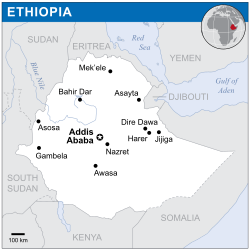 |
|
| Capital and largest city |
Addis Ababa 9°1′N 38°45′E |
| Official languages | Amharic (federal)[1] |
| Working languages | Federation member languages |
| Regional languages | |
| Religion | Christianity (62.8%) Islam (33.9%) traditional faiths (2.6%) others (0.6%)[2] |
| Demonym | Ethiopian |
| Government | Federal dominant-party parliamentary republic |
| Mulatu Teshome | |
| Abiy Ahmed Ali | |
| Legislature | Federal Parliamentary Assembly |
| House of Federation | |
| House of Peoples' Representatives | |
| Formation | |
• Dʿmt
|
c. 980 BC |
| c. 100 AD | |
| 1137 | |
• Derg
|
1974 |
| 1987 | |
| August 1995 | |
| Area | |
• Total
|
1,104,300 km2 (426,400 sq mi) (26th) |
• Water (%)
|
0.7 |
| Population | |
• 2016 estimate
|
102,403,196[3] (12th) |
• 2007 census
|
73,750,932[4] |
• Density
|
92.7/km2 (240.1/sq mi) (123rd) |
| GDP (PPP) | 2018 estimate |
• Total
|
$216.449 billion[5] |
• Per capita
|
$2,299.26[5] |
| GDP (nominal) | 2018 estimate |
• Total
|
$87.303 billion[5] |
• Per capita
|
$927.39[5] |
| Gini (2011) | medium |
| HDI (2015) | low · 174th |
| Currency | Birr (ETB) |
| Time zone | EAT (UTC+3) |
| Drives on the | right |
| Calling code | +251 |
| ISO 3166 code | ET |
| Internet TLD | .et |
Some of the oldest skeletal evidence for anatomically modern humans has been found in Ethiopia.[9] It is widely considered as the region from which modern humans first set out for the Middle East and places beyond.[10][11][12] According to linguists, the first Afroasiatic-speaking populations settled in the Horn region during the ensuing Neolithic era.[13] Tracing its roots to the 2nd millennium BC, Ethiopia's governmental system was a monarchy for most of its history. In the first centuries AD, the Kingdom of Aksum maintained a unified civilization in the region,[14][15][16][17] followed by the Ethiopian Empire circa 1137. During the late 19th-century Scramble for Africa, Ethiopia was one of the nations to retain its sovereignty from long-term colonialism by a European colonial power. Many newly-independent nations on the continent subsequently adopted its flag colours. Ethiopia was also the first independent member from Africa of the 20th-century League of Nations and the United Nations.[18] In 1974, the Ethiopian monarchy under Haile Selassie was overthrown by the Derg, a communist military government backed by the Soviet Union. In 1987, the Derg established the People's Democratic Republic of Ethiopia, but it was overthrown in 1991 by the Ethiopian People's Revolutionary Democratic Front, which has been the ruling political coalition since.
Ethiopia and Eritrea use the ancient Ge'ez script, which is one of the oldest alphabets still in use in the world.[19] The Ethiopian calendar, which is approximately seven years and three months behind the Gregorian calendar, co-exists alongside the Borana calendar. A majority of the population adheres to Christianity (mainly the Ethiopian Orthodox Tewahedo Church and P'ent'ay), whereas around a third follows Islam (primarily Sunni). The country is the site of the Migration to Abyssinia and the oldest Muslim settlement in Africa at Negash. A substantial population of Ethiopian Jews, known as Bete Israel, also resided in Ethiopia until the 1980s.[20][21] Ethiopia is a multilingual nation with around 80 ethnolinguistic groups, the four largest of which are the Oromo, Amhara, Somali and Tigrayans. Most people in the country speak Afroasiatic languages of the Cushitic or Semitic branches. Additionally, Omotic languages are spoken by ethnic minority groups inhabiting the southern regions. Nilo-Saharan languages are also spoken by the nation's Nilotic ethnic minorities.
The nation is a land of natural contrasts, with its vast fertile west, its forests, and numerous rivers, and the world's hottest settlement of Dallol in its north. The Ethiopian Highlands are the largest continuous mountain ranges in Africa, and the Sof Omar Caves contains the largest cave on the continent. Ethiopia also has the most UNESCO World Heritage Sites in Africa.[22] Additionally, the country is one of the founding members of the UN, the Group of 24 (G-24), the Non-Aligned Movement, G-77 and the Organisation of African Unity. Its capital city Addis Ababa serves as the headquarters of the African Union, the Pan African Chamber of Commerce and Industry, the United Nations Economic Commission for Africa, the African Standby Force, and many of the global NGOs focused on Africa. In the 1970s and 1980s, Ethiopia experienced civil conflicts and communist purges, which hindered its economy. The country has since recovered and now has the largest economy (by GDP) in East and Central Africa.[23][24][25] According to Global Fire Power, Ethiopia also has the 51st most powerful military in the world, and the fourth most powerful in Africa.[26]
Contents
Nomenclature
The Greek name Αἰθιοπία (from Αἰθίοψ, Aithiops, 'an Ethiopian') is a compound word, derived from the two Greek words, from αἴθω + ὤψ (aitho "I burn" + ops "face"). According to the Perseus Digital Library, the designation properly translates as Burnt-face in noun form and red-brown in adjectival form.[27] The historian Herodotus used the appellation to denote the parts of Africa below the Sahara that were then known within the Ecumene (inhabitable world).[28] However, the Greek formation may be a folk etymology for the Ancient Egyptian term athtiu-abu, which means 'robbers of hearts'.[29]In Greco-Roman epigraphs, Aethiopia was a specific toponym for ancient Nubia.[30] At least as early as c. 850,[31] the name Aethiopia also occurs in many translations of the Old Testament in allusion to Nubia. The ancient Hebrew texts identify Nubia instead as Kush.[32] However, in the New Testament, the Greek term Aithiops does occur, referring to a servant of Candace or Kandake, possibly an inhabitant of Meroë in Nubia.[33]
Following the Hellenic and Biblical traditions, the Monumentum Adulitanum, a third century inscription belonging to the Aksumite Empire, indicates that Aksum's then ruler governed an area which was flanked to the west by the territory of Ethiopia and Sasu. The Aksumite King Ezana would eventually conquer Nubia the following century, and the Aksumites thereafter appropriated the designation "Ethiopians" for their own kingdom. In the Ge'ez version of the Ezana inscription, Aἰθιόποι is equated with the unvocalized Ḥbštm and Ḥbśt (Ḥabashat), and denotes for the first time the highland inhabitants of Aksum. This new demonym would subsequently be rendered as ’ḥbs (’Aḥbāsh) in Sabaic and as Ḥabasha in Arabic.[30]
In the 15th-century Ge'ez Book of Aksum, the name is ascribed to a legendary individual called Ityopp'is. He was an extra-Biblical son of Cush, son of Ham, said to have founded the city of Axum.[34]
In English, and generally outside of Ethiopia, the country was once historically known as Abyssinia. This toponym was derived from the Latinized form of the ancient Habash.[35]
History
Prehistory
A Homo sapiens idaltu hominid skull
Ethiopia is also considered one of the earliest sites of the emergence of anatomically modern humans, Homo sapiens. The oldest of these local fossil finds, the Omo remains, were excavated in the southwestern Omo Kibish area and have been dated to the Middle Paleolithic, around 200,000 years ago.[40] Additionally, skeletons of Homo sapiens idaltu were found at a site in the Middle Awash valley. Dated to approximately 160,000 years ago, they may represent an extinct subspecies of Homo sapiens, or the immediate ancestors of anatomically modern humans.[41] Homo sapiens fossils excavated at the Jebel Irhoud site in Morocco have since been dated to an earlier period, about 300,000 years ago.[42]
According to linguists, the first Afroasiatic-speaking populations arrived in the region during the ensuing Neolithic era from the family's proposed urheimat ("original homeland") in the Nile Valley,[13] or the Near East.[43] Other scholars propose that the Afroasiatic family developed in situ in the Horn, with its speakers subsequently dispersing from there.[44] Craniometric analysis of the Herto Homo sapiens idaltu skull found that the fossil was morphologically distinct from crania belonging to modern Afroasiatic-speaking groups from the Horn of Africa and Dynastic Egypt. The latter populations instead possessed Middle Eastern affinities. This suggests that the Afroasiatic-speaking groups settled in the area during a later epoch, having possibly arrived from the Middle East.[45]
Antiquity
Around the 8th century BC, a kingdom known as Dʿmt was established in northern Ethiopia and Eritrea. The polity's capital was located at Yeha, in northern Ethiopia. Most modern historians consider this civilization to be a native Ethiopian one, although Sabaean-influenced because of the latter's hegemony of the Red Sea.[15]Other scholars regard Dʿmt as the result of a union of Afroasiatic-speaking cultures of the Cushitic and Semitic branches; namely, local Agaw peoples and Sabaeans from South Arabia. However, Ge'ez, the ancient Semitic language of Ethiopia, is thought to have developed independently from Sabaean, one of the South Semitic languages. As early as 2000 BC, other Semitic speakers were living in Ethiopia and Eritrea where Ge'ez developed.[46][47] Sabaean influence is now thought to have been minor, limited to a few localities, and disappearing after a few decades or a century. It may have been a trading or military colony in alliance with the Ethiopian civilization of Dʿmt or some other proto-Aksumite state.[15]
Aksumite currency of the Aksumite king Endubis, 227–35, at the British Museum. The inscriptions in Ancient Greek read "ΑΧΩΜΙΤΩ ΒΑΣΙΛΕΥΣ" ("KING OF AXUM") and "ΕΝΔΥΒΙΣ ΒΑΣΙΛΕΥΣ" ("KING ENDUBIS"), the Greek language was the lingua franca by that time so the Axumite kings used it in coins to simplify foreign trade.
Around 316 AD, Frumentius and his brother Edesius from Tyre accompanied their uncle on a voyage to Ethiopia. When the vessel stopped at a Red Sea port, the natives killed all the travelers except the two brothers, who were taken to the court as slaves. They were given positions of trust by the monarch, and they converted members of the royal court to Christianity. Frumentius became the first bishop of Aksum.[50] A coin dated to 324 shows that Ethiopia was the second country to officially adopt Christianity (after Armenia did so in 301), although the religion may have been at first confined to court circles; it was the first major power to do so.
As the Aksumite kingdom gradually declined, one of the earliest local Muslim states, the Makhzumi Sultanate, was established in the Shewa region. The polity was governed by the Makhzumi dynasty, which reigned over the province until it was deposed around 1280 by the Walashma dynasty.[51]
During Muhammad's era
The first interaction that the Islamic Prophet Muhammad had with Ethiopia was during the reign of Aṣḥama ibn Abjar, who was at the time the Emperor of Aksum and gave refuge to several Muslims in the Kingdom of Aksum in 614 AD.[52] According to other authors, Ashama may have been the same person as king Armah, or his father or son.[53] Taddesse Tamrat records that the inhabitants of Wiqro, where the ruler is known as Ashamat al-Negashi, claim that his tomb is located in their village.[54][55]Muhammad's second interaction with Ethiopia was during the Expedition of Zaid ibn Haritha, when he sent Amr bin Umayyah al-Damri to the King of Ethiopia (then Abyssinia).[56]
Middle Ages
In the early 15th century, Ethiopia sought to make diplomatic contact with European kingdoms for the first time since the Aksumite era. A letter from Henry IV of England to the Emperor of Abyssinia survives.[58] In 1428, Yeshaq I sent two emissaries to Alfonso V of Aragon, who sent return emissaries. They failed to complete the return trip.[59] The first continuous relations with a European country began in 1508 with Portugal under Dawit II (Lebna Dengel), who had just inherited the throne from his father.[60]
The castle of Fasilides
Aussa Sultanate
The Sultanate of Aussa or "Afar Sultanate" succeeded the earlier Imamate of Aussa. The latter polity had come into existence in 1577 when Muhammed Jasa moved his capital from Harar to Aussa (Asaita) with the split of the Adal Sultanate into the Sultanate of Aussa and the Sultanate of Harar. At some point after 1672, the Sultanate of Aussa declined and temporarily came to an end in conjunction with Imam Umar Din bin Adam's recorded ascension to the throne.[65]The Sultanate was subsequently re-established by Kedafu around the year 1734. It was thereafter ruled by his Mudaito Dynasty.[66] The primary symbol of the Sultan was a silver baton, which was considered to have magical properties.[67]
Zemene Mesafint
Emperor Tewodros II's rule is often placed as the beginning of modern Ethiopia, ending the decentralized Zemene Mesafint ("Era of the Princes").
But Tewodros suffered several rebellions inside his empire. Northern Oromo militias, Tigrayan rebellion, and the constant incursion of Ottoman Empire and Egyptian forces near the Red Sea brought the weakening and the final downfall of Tewodros II. He killed himself in 1868 during his last battle with the British Expedition to Abyssinia. Emperor Tewodros II was born in Begemder from a nobleman of Qwara, where the Qwara dialect of Agaw language is spoken.
After Tewodros' death, Tekle Giyorgis II was proclaimed Emperor. He was defeated in the Battles of Zulawu (21 June 1871) and Adua (11 July 1871). Kassai was subsequently declared Yohannes IV on 21 January 1872. In 1875 and 1876, Turkish/Egyptian forces, accompanied by many European and American 'advisors', twice invaded Abyssinia but were initially defeated: once at the Battle of Gundet losing 800 men, and then in the second invasion, decisively defeated by Emperor Yohannes IV at the Battle of Gura on 7 March 1875, where the invading forces lost at least 3000 men by death or captured.[70] From 1885 to 1889, Ethiopia joined the Mahdist War allied to Britain, Turkey, and Egypt against the Sudanese Mahdist State. On 10 March 1889, Yohannes IV was killed by the Sudanese Khalifah Abdullah's army whilst leading his army in the Battle of Gallabat (also called Battle of Metemma).[71]
From Menelik II to Adwa (1889–1913)
Emperor Menelik II, former Governor of Shewa
Ethiopia and other territories in Africa in 1843
During his reign, Menelik II made advances in road construction, electricity and education; the development of a central taxation system; and the foundation and building of the city of Addis Ababa—which became capital of Shewa Province in 1881. After he ascended to the throne in 1889, it was renamed as Addis Ababa, the new capital of Abyssinia. Menelik had signed the Treaty of Wichale with Italy in May 1889 in which Italy would recognize Ethiopia's sovereignty so long as Italy could control an area north of Ethiopia (part of modern Eritrea). In return, Italy was to provide Menelik with weapons and support him as emperor. The Italians used the time between the signing of the treaty and its ratification by the Italian government to expand their territorial claims. This conflict erupted in the Battle of Adwa on 1 March 1896 in which Italy's colonial forces were defeated by the Ethiopians.[73][79]
About a third of the population died in the Great Ethiopian Famine (1888 to 1892).[80][81]
Haile Selassie I era (1916–1974)
Haile Selassie at his study at the palace
The independence of Ethiopia was interrupted by the Second Italo-Ethiopian War, beginning when it was invaded by Fascist Italy in early October 1935, and Italian occupation of the country (1936–1941).[82] During this time, Haile Selassie appealed to the League of Nations in 1935, delivering an address that made him a worldwide figure, and the 1935 Time Man of the Year.[83] As the majority of the Ethiopian population lived in rural towns, Italy faced continued resistance and ambushes in urban centers throughout its occupation. Haile Selassie fled into exile in Fairfield House, Bath and Mussolini was able to proclaim the Empire of Ethiopia and the assumption of the imperial title by the Italian king Vittorio Emanuele III, recognized by the countries belonging to the international organization of the League of Nations.[84]
In 1937, the Italian massacre of Yekatit 12 occurred. This was when there were imprisonments and massacre of Ethiopians. This was because of a failed attempt to assassinate the Viceroy of Italian East Africa Rodolfo Graziani.[citation needed]
The 1897 Ethiopian flag with the Lion of Judah
On 26 August 1942, Haile Selassie issued a proclamation that removed Ethiopia's legal basis for slavery.[86] Ethiopia had between two and four million slaves in the early 20th century, out of a total population of about eleven million.[87]
In 1952, Haile Selassie orchestrated the federation with Eritrea. He dissolved this in 1962 and illegally annexed Eritrea against the UN Federation Agreement, which resisted and finally won its war of independence. Haile Selassie played a leading role in the formation of the Organisation of African Unity (OAU) in 1963.[citation needed]
Opinion within Ethiopia turned against Haile Selassie I owing to the worldwide oil crisis of 1973. This oil crisis caused a sharp increase in gasoline prices starting on 13 February 1974; food shortages; uncertainty regarding the succession; border wars; and discontent in the middle class created through modernization.[88] The high gasoline prices motivated the taxi drivers and teachers to go on strike on 18 February 1974, and students and workers in Addis Ababa began demonstrating against the government on 20 February 1974.[89] The feudal oligarchial cabinet of Akilou Habte Wolde was toppled, and a new government was formed with Endelkachew Makonnen serving as Prime Minister.[90]
Derg era (1974–1991)
The ensuing regime suffered several coups, uprisings, wide-scale drought, and a huge refugee problem. In 1977, Somalia, which had been receiving assistance and arms from the USSR, invaded Ethiopia in the Ogaden War, capturing part of the Ogaden region. Ethiopia recovered it after it began receiving massive military aid from the USSR, Cuba, South Yemen, East Germany,[92] and North Korea. This included around 15,000 Cuban combat troops.[citation needed]
Between 1977–78, up to 500,000 were killed as a result of the Red Terror,[93] from forced deportations, or from the use of hunger as a weapon under Mengistu's rule.[88] The Red Terror was carried out in response to what the Derg termed as the White Terror, a chain of violent events, assassinations, and killings carried out by what it called "petty bourgeois reactionaries" who desired a reversal of the 1974 revolution.[94][95]
The 1983–85 famine in Ethiopia affected around eight million people, resulting in one million dead. Insurrections against Communist rule sprang up, particularly in the northern regions of Eritrea and Tigray. In 1989, the Tigrayan People's Liberation Front (TPLF) merged with other ethnically based opposition movements to form the coalition known as the Ethiopian People's Revolutionary Democratic Front (EPRDF).[citation needed]
Flag of the People's Democratic Republic of Ethiopia
In May 1991, EPRDF forces advanced on Addis Ababa and the Soviet Union did not intervene to save the government side. Mengistu fled the country and was granted asylum in Zimbabwe, where he still resides.[citation needed]
In 2006, after a trial that lasted 12 years, Ethiopia's Federal High Court in Addis Ababa found Mengistu guilty of genocide in absentia.[96] Numerous other top leaders of his regime were also found guilty of war crimes. Mengistu and others who had fled the country were tried and sentenced in absentia. Numerous former officials received the death sentence and tens of others spent the next 20 years in jail, before being pardoned from life sentences.[citation needed]
In July 1991, EPRDF convened a National Conference to establish the Transitional Government of Ethiopia composed of an 87-member Council of Representatives and guided by a national charter that functioned as a transitional constitution.[97] In June 1992, the Oromo Liberation Front withdrew from the government; in March 1993, members of the Southern Ethiopia Peoples' Democratic Coalition also left the government.[citation needed] In 1994, a new constitution was written that established a parliamentary republic with a bicameral legislature and a judicial system.[1]
Federal Democratic Republic (1991–present)
Former Prime Minister Meles Zenawi at the 2012 World Economic Forum annual meeting
In May 1998, a border dispute with Eritrea led to the Eritrean–Ethiopian War, which lasted until June 2000 and cost both countries an estimated $1 million a day.[100] This had a negative effect on Ethiopia's economy,[101] but strengthened the ruling coalition.[citation needed]
Ethiopia's 3rd multiparty election on 15 May 2005 was highly disputed, with some opposition groups claiming fraud. Though the Carter Center approved the pre-election conditions, it expressed its dissatisfaction with post-election events. European Union election observers cited state support for the EPRDF campaign, as well as irregularities in ballot counting and results publishing.[102] The opposition parties gained more than 200 parliamentary seats, compared with just 12 in the 2000 elections. While most of the opposition representatives joined the parliament, some leaders of the CUD party who refused to take up their parliamentary seats were accused of inciting the post-election violence and were imprisoned. Amnesty International considered them "prisoners of conscience" and they were subsequently released.[103]
A coalition of opposition parties and some individuals was established in 2009 to oust the regime of the EPRDF in legislative elections of 2010. Meles' party, which has been in power since 1991, published its 65-page manifesto in Addis Ababa on 10 October 2009. The opposition won most votes in Addis Ababa, but the EPRDF halted counting of votes for several days. After it ensued, it claimed the election, amidst charges of fraud and intimidation.[104]
The Ministry of Finance and Economic Development headquarters
In mid-2011, two consecutively missed rainy seasons precipitated the worst drought in East Africa seen in 60 years. Full recovery from the drought's effects did not occur until 2012, with long-term strategies by the national government in conjunction with development agencies believed to offer the most sustainable results.[105]
Former Primie Minister of Ethiopia Hailemariam Desalegn meeting with former US Deputy Secretary of Defense Ash Carter in Addis Ababa.
Protests broke out across the country on 5 August 2016 and dozens of protesters were subsequently shot and killed by police. The protesters demanded an end to human rights abuses, the release of political prisoners, a fairer redistribution of the wealth generated by over a decade of economic growth, and a return of Wolqayt District to the Amhara Region.[109][110][111] The events were the most violent crackdown against protesters in Sub-Saharan Africa since the Ethiopian regime killed at least 75 people during protests in the Oromia Region in November and December 2015.[112][113] Following these protests, Ethiopia declared a state of emergency on 6 October 2016.[114] The state of emergency was lifted in August 2017.[115]
On February 16, 2018, the government of Ethiopia declared a six-month nationwide state of emergency following the resignation of Prime Minister Hailemariam Desalegn.[116] Hailemariam is the first ruler in modern Ethiopian history to step down; previous leaders have died in office or been overthrown.[117] He said he wanted to clear the way for reforms.
Politics
Ethiopian embassy in Washington, D.C.
Prime Minister of Ethiopia Abiy Ahmed Ali
In July 2015, during a trip that then US President Barack Obama took to Ethiopia, he highlighted the role of the country in the fight against Islamic terrorism.[121] Obama was the first sitting United States president to visit Ethiopia.
Governance
The election of Ethiopia's 547-member constituent assembly was held in June 1994. This assembly adopted the constitution of the Federal Democratic Republic of Ethiopia in December 1994. The elections for Ethiopia's first popularly chosen national parliament and regional legislatures were held in May and June 1995. Most opposition parties chose to boycott these elections. There was a landslide victory for the Ethiopian People's Revolutionary Democratic Front (EPRDF). International and non-governmental observers concluded that opposition parties would have been able to participate had they chosen to do so.
Addis Ababa's city hall
Citizens have little access to media other than the state-owned networks, and most private newspapers struggle to remain open and suffer periodic harassment from the government.[122] At least 18 journalists who had written articles critical of the government were arrested following the 2005 elections on genocide and treason charges. The government uses press laws governing libel to intimidate journalists who are critical of its policies.[123]
Meles' government was elected in 2000 in Ethiopia's first-ever multiparty elections; however, the results were heavily criticized by international observers and denounced by the opposition as fraudulent. The EPRDF also won the 2005 election returning Meles to power. Although the opposition vote increased in the election, both the opposition and observers from the European Union and elsewhere stated that the vote did not meet international standards for fair and free elections.[122] Ethiopian police are said to have massacred 193 protesters, mostly in the capital Addis Ababa, in the violence following the May 2005 elections in the Ethiopian police massacre.[124]
Former Foreign Minister of Ethiopia Tedros Adhanom with former U.S. Secretary of State John Kerry
In 2008, the top five opposition parties were the Unity for Democracy and Justice led by Judge Birtukan Mideksa, United Ethiopian Democratic Forces led by Dr. Beyene Petros, Oromo Federalist Democratic Movement led by Dr. Bulcha Demeksa, Oromo People's Congress led by Dr. Merera Gudina, and United Ethiopian Democratic Party – Medhin Party led by Lidetu Ayalew. After the 2015 elections, Ethiopia lost its single remaining opposition MP;[125] there are now no opposition MPs in the Ethiopian parliament.[126]
Human rights
Merera Gudina, leader of the Oromo People's Congress, said the East African country was at a "crossroads". "People are demanding their rights," he said. "People are fed up with what the regime has been doing for a quarter of a century. They're protesting against land grabs, reparations, stolen elections, the rising cost of living, many things. "If the government continue to repress while the people are demanding their rights in the millions that (civil war) is one of the likely scenarios," Merera said in an interview with Reuters.[130]
According to surveys in 2003 by the National Committee on Traditional Practices in Ethiopia, marriage by abduction accounts for 69% of the nation's marriages, with around 80% in the largest region, Oromiya, and as high as 92% in the Southern Nations, Nationalities, and Peoples' Region.[131][132] Homosexual acts are illegal in Ethiopia.[133]
Among the Omotic Karo-speaking and Hamer peoples in southern Ethiopia, adults and children with physical abnormalities are considered to be mingi, "ritually impure". The latter are believed to exert an evil influence upon others; disabled infants have traditionally been murdered without a proper burial.[134] The Karo officially banned the practice in July 2012.[135]
In 2013, the Oakland Institute released a report accusing the Ethiopian government of forcing the relocation of "hundreds of thousands of indigenous people from their lands" in the Gambela Region[136] The report describes the Ethiopian government's "plans to move over 1.5 million people" by the end of 2013, in order to allow foreign investors to develop the land for large scale industrial agriculture.[136] According to several reports by the organization, those who refused were the subject of a variety of intimidation techniques including physical and sexual abuse, which sometimes led to deaths.[137][138][139] A similar 2012 report by Human Rights Watch also describes the Ethiopian government's 2010–2011 villagization program in Gambella, with plans to carry out similar resettlements in other regions.[140] The Ethiopian government has denied the accusations of land grabbing and instead pointed to the positive trajectory of the countries economy as evidence of the development program's benefits.[139]
Administrative divisions
Before 1996, Ethiopia was divided into thirteen provinces, many derived from historical regions. The nation now has a tiered governmental system consisting of a federal government overseeing ethnically based regional states, zones, districts (woreda), and kebeles ("neighbourhoods").Since 1996, Ethiopia has been divided into nine ethnically-based and politically autonomous regional states (kililoch, singular kilil ) and two chartered cities (astedader akababiwoch, singular astedader akababi ), the latter being Addis Ababa and Dire Dawa. The kililoch are subdivided into sixty-eight zones, and then further into 550 woredas and several special woredas.
The constitution assigns extensive power to regional states, which can establish their own government and democracy as long as it is in line with the federal government's constitution. Each region has at its apex a regional council where members are directly elected to represent the districts and the council has legislative and executive power to direct internal affairs of the regions.
Article 39 of the Ethiopian Constitution further gives every regional state the right to secede from Ethiopia. There is debate, however, as to how much of the power guaranteed in the constitution is actually given to the states. The councils implement their mandate through an executive committee and regional sectoral bureaus. Such elaborate structure of council, executive, and sectoral public institutions is replicated to the next level (woreda).
| Region or city (ክልል/የከተማ አስተዳድር) | Capital | Area (km2) | Population[141] | |||
|---|---|---|---|---|---|---|
| Oct 1994 census | May 2007 census | Jul 2012 estimate | ||||
| Addis Ababa (አዲስ አበባ) | astedader | Addis Ababa | 526.99 | 2,100,031 | 2,738,248 | 3,041,002 |
| Afar (ዓፋር) | kilil | Semera | 72,052.78 | 1,051,641 | 1,411,092 | 1,602,995 |
| Amhara (አማራ) | kilil | Bahir Dar | 154,708.96 | 13,270,898 | 17,214,056 | 18,866,002 |
| Benishangul-Gumuz (ቤ/ጉሙዝ) | kilil | Asosa | 50,698.68 | 460,325 | 670,847 | 982,004 |
| Dire Dawa (ድሬዳዋ) | astedader | Dire Dawa | 1,558.61 | 248,549 | 342,827 | 387,000 |
| Gambela (ጋምቤላ) | kilil | Gambela | 29,782.82 | 162,271 | 306,916 | 385,997 |
| Harari (ሐረሪ) | kilil | Harar | 333.94 | 130,691 | 183,344 | 210,000 |
| Oromia (ኦሮምያ) | kilil | Addis Ababa | 284,538 | 18,465,449 | 27,158,471 | 31,294,992 |
| Somali (ሶማሌ) | kilil | Jijiga | 279,252.00 | 3,144,963 | 4,439,147 | 5,148,989 |
| Southern Nations, Nationalities, and Peoples' Region (ደቡብ ብ/ብ/ሕ) | kilil | Awasa | 105,887.18 | 10,377,028 | 15,042,531 | 17,359,008 |
| Tigray (ትግራይ) | kilil | Mek'ele | 41,410 | 3,134,470 | 4,314,456 | 4,929,999 |
| Special enumerated zones | 96,570 | 112,999 | ||||
| Totals | 1,127,127.00 | 51,766,239 | 73,918,505 | 84,320,987 | ||
Geography
Ethiopia map of Köppen climate classification
The major portion of Ethiopia lies on the Horn of Africa, which is the easternmost part of the African landmass. Bordering Ethiopia are Sudan and South Sudan to the west, Djibouti and Eritrea to the north, Somalia to the east and Kenya to the south. Within Ethiopia is a vast highland complex of mountains and dissected plateaus divided by the Great Rift Valley, which runs generally southwest to northeast and is surrounded by lowlands, steppes, or semi-desert. The great diversity of terrain determines wide variations in climate, soils, natural vegetation, and settlement patterns.
Ethiopia is an ecologically diverse country, ranging from the deserts along the eastern border to the tropical forests in the south to extensive Afromontane in the northern and southwestern parts. Lake Tana in the north is the source of the Blue Nile. It also has a large number of endemic species, notably the gelada, the walia ibex and the Ethiopian wolf ("Simien fox"). The wide range of altitude has given the country a variety of ecologically distinct areas, and this has helped to encourage the evolution of endemic species in ecological isolation.
Climate
The predominant climate type is tropical monsoon, with wide topographic-induced variation. The Ethiopian Highlands cover most of the country and have a climate which is generally considerably cooler than other regions at similar proximity to the Equator. Most of the country's major cities are located at elevations of around 2,000–2,500 m (6,562–8,202 ft) above sea level, including historic capitals such as Gondar and Axum.
Wonchi Lake
There are on average 7 hours of sunshine per day. The dry season is the sunniest time of the year, though even at the height of the rainy season in July and August there are still usually several hours per day of bright sunshine. The average annual temperature in Addis Ababa is 16 °C (60.8 °F), with daily maximum temperatures averaging 20–25 °C (68.0–77.0 °F) throughout the year, and overnight lows averaging 5–10 °C (41.0–50.0 °F).
Most major cities and tourist sites in Ethiopia lie at a similar elevation to Addis Ababa and have a comparable climate. In less elevated regions, particularly the lower lying Ethiopian xeric grasslands and shrublands in the east of the country, the climate can be significantly hotter and drier. Dallol, in the Danakil Depression in this eastern zone, has the world's highest average annual temperature of 34 °C (93.2 °F).
Environment
Wildlife
The Ethiopian wolf
Ethiopia is a global center of avian diversity. To date more than 856 bird species have been recorded in Ethiopia, twenty of which are endemic to the country.[144] Sixteen species are endangered or critically endangered. A large number of these birds feed on butterflies, like the Bicyclus anynana.[145]
A papilionidae at Lake Tana
Ethiopia has a large number of species listed as critically endangered, endangered, and vulnerable to global extinction. The threatened species in Ethiopia can be broken down into three categories (based on IUCN ratings): critically endangered, endangered, and vulnerable.[143]
Deforestation
Mountain nyalas in Bale Mountains National Park, one of several wildlife reserves in Ethiopia
Ethiopia loses an estimated 1,410 km2 of natural forests each year. Between 1990 and 2005 the country lost approximately 21,000 km2 of forests.[citation needed] Current government programs to control deforestation consist of education, promoting reforestation programs, and providing raw materials which are alternatives to timber. In rural areas the government also provides non-timber fuel sources and access to non-forested land to promote agriculture without destroying forest habitat.[citation needed] [153]
Organizations such as SOS and Farm Africa are working with the federal government and local governments to create a system of forest management.[154] Working with a grant of approximately 2.3 million Euros, the Ethiopian government recently began training people on reducing erosion and using proper irrigation techniques that do not contribute to deforestation. This project is assisting more than 80 communities.[citation needed]
Economy
Ethiopia's Human Development Index rating 1970–2010
In 2008 and 2011, Ethiopia's growth performance and considerable development gains were challenged by high inflation and a difficult balance of payments situation. Inflation surged to 40% in August 2011 because of loose monetary policy, large civil service wage increase in early 2011, and high food prices.[158] For 2011/12, end-year inflation was projected to be about 22%, and single digit inflation is projected in 2012/13 with the implementation of tight monetary and fiscal policies.[159]
In spite of fast growth in recent years, GDP per capita is one of the lowest in the world, and the economy faces a number of serious structural problems. However, with a focused investment in public infrastructure and industrial parks, Ethiopia's economy is addressing its structural problems to become a hub for light manufacturing in Africa.[160]
The Ethiopian constitution defines the right to own land as belonging only to "the state and the people", but citizens may lease land (up to 99 years), and are unable to mortgage or sell. Renting of land for a maximum of twenty years is allowed and this is expected to ensure that land goes to the most productive user. Land distribution and administration is considered an area where corruption is institutionalized, and facilitation payments as well as bribes are often demanded when dealing with land-related issues.[161] As there is no land ownership, infrastructural projects are most often simply done without asking the land users, which then end up being displaced and without home or land. A lot of anger and distrust sometimes results in public protests. In addition, agricultural productivity remains low, and frequent droughts still beset the country, also leading to internal displacement.[162]
Energy and hydropower
Layout of the Grand Renaissance Dam.
Ethiopia delivers roughly 81% of water volume to the Nile through the river basins of the Blue Nile, Sobat River and Atbara. In 1959, Egypt and Sudan signed a bilateral treaty, the 1959 Nile Waters Agreement, which gave both countries exclusive maritime rights over the Nile waters. Ever since, Egypt under international law vetoed almost all projects in Ethiopia that sought to utilize the local Nile tributaries. This had the effect of discouraging external financing of hydropower and irrigation projects in western Ethiopia, thereby impeding water resource-based economic development projects. However, Ethiopia is in the process of constructing a large 6,450 MW hydroelectric dam on the Blue Nile river. When completed, this Grand Ethiopian Renaissance Dam is slated to be the largest hydroelectric power station on the continent.[163] The Gibe III hydroelectric project already generates an estimated 1,870-MW.[164]
Agriculture
Agriculture constitutes around 85% of the labour force. However, the service sector represents the largest portion of the GDP.[8] Many other economic activities depend on agriculture, including marketing, processing, and export of agricultural products. Production is overwhelmingly by small-scale farmers and enterprises, and a large part of commodity exports are provided by the small agricultural cash-crop sector. Principal crops include coffee, legumes, oilseeds, cereals, potatoes, sugarcane, and vegetables.Exports are almost entirely agricultural commodities (with the exception of Gold exports), and coffee is the largest foreign exchange earner. Ethiopia is Africa's second biggest maize producer.[165] According to UN estimations the per capita GDP of Ethiopia has reached $357 as of 2011.[166] The same report indicated that the life expectancy had improved substantially in recent years. The life expectancy of men is reported to be 56 years and for women 60 years.
Exports
Exports from Ethiopia in the 2009/2010 financial year totaled 1.4 billion USD.[167] The country produces more coffee than any other nation on the continent.[168]Cross-border trade by pastoralists is often informal and beyond state control and regulation. In East Africa, over 95% of cross-border trade is through unofficial channels. The unofficial trade of live cattle, camels, sheep, and goats from Ethiopia sold to Somalia, Djibouti, and Kenya generates an estimated total value of between 250 and 300 million USD annually (100 times more than the official figure).[171]
This trade helps lower food prices, increase food security, relieve border tensions, and promote regional integration.[171] However, the unregulated and undocumented nature of this trade runs risks, such as allowing disease to spread more easily across national borders. Furthermore, the government of Ethiopia is purportedly unhappy with lost tax revenue and foreign exchange revenues.[171] Recent initiatives have sought to document and regulate this trade.[171]
Ethiopian Blessed Coffee brand bags in Takoma Park, Maryland. Coffee is one of Ethiopia's main exports.
Coffee remains its most important export product, and with new trademark deals around the world (including recent deals with Starbucks) the country plans to increase its revenue from coffee.[175] Most regard Ethiopia's large water resources and potential as its "white oil" and its coffee resources as "black gold".[176][177]
The country also has large mineral resources and oil potential in some of the less inhabited regions. Political instability in those regions, however, has inhibited development. Ethiopian geologists were implicated in a major gold swindle in 2008. Four chemists and geologists from the Ethiopian Geological Survey were arrested in connection with a fake gold scandal, following complaints from buyers in South Africa. Gold bars from the National Bank of Ethiopia were found by police to be gilded metal, costing the state around 17 million USD, according to the Science and Development Network website.[178]
In 2011, the Grand Ethiopian Renaissance Dam project was commenced. When completed, it will provide surplus energy in Ethiopia which will be available for export to neighboring countries.
Transportation
Beyond the first 270 km of the Awash – Hara Gebeya Railway, a second construction phase over 120 km foresees the extension of this railway from Dessie/Kombolcha to Hara Gebeya/Woldiya. It is not clear, when this section will be built and opened.[181] A third, northern 216 km long railway is also under construction between Mek'ele and Woldiya, but it is also not clear, when this railway will be commissioned and opened.[182] All railways are part of a future railway network of more than 5,000 km of railways, the National Railway Network of Ethiopia.
Light rail in Addis Ababa, Ethiopia
Ethiopia had 58 airports as of 2012,[8] and 61 as of 2016.[184] Among these, the Bole International Airport in Addis Ababa and the Aba Tenna Dejazmach Yilma International Airport in Dire Dawa accommodate international flights. Ethiopian Airlines is the country's flag carrier, and is wholly owned by the Government of Ethiopia.[185] From its hub at the Bole International Airport, the airline serves a network of 102 international 20 domestic passenger, and 44 cargo, destinations.[186][187] It is also one of the fastest-growing carriers in the industry and continent.[188]
Demographics
Ethiopia's population has grown from 33.5 million in 1983 to 87.9 million in 2014.[189] The population was only about 9 million in the 19th century.[190] The 2007 Population and Housing Census results show that the population of Ethiopia grew at an average annual rate of 2.6% between 1994 and 2007, down from 2.8% during the period 1983–1994. Currently, the population growth rate is among the top ten countries in the world. The population is forecast to grow to over 210 million by 2060, which would be an increase from 2011 estimates by a factor of about 2.5.[191]| Population in Ethiopia[192] | |||
|---|---|---|---|
| Year | Million | Difference | |
| 1950 | 18.4 | – | |
| 1960 | 22.5 | 4.1 | |
| 1970 | 29.0 | 6.5 | |
| 1980 | 35.4 | 6.4 | |
| 1990 | 48.3 | 12.9 | |
| 2000 | 65.6 | 17.3 | |
| 2010 | 82.9 | 17.3 | |
| 2013 | 93.8 | >10.9 | |
Afroasiatic-speaking communities make up the majority of the population. Among these, Semitic speakers often collectively refer to themselves as the Habesha people. The Arabic form of this term (al-Ḥabasha) is the etymological basis of "Abyssinia," the former name of Ethiopia in English and other European languages.[193] Additionally, Nilo-Saharan-speaking ethnic minorities inhabit the southern regions of the country, particularly in areas of the Gambela Region which borders South Sudan. The largest ethnic groups among these include the Nuer and Anuak.
In 2009, Ethiopia hosted a population of refugees and asylum seekers numbering approximately 135,200. The majority of this population came from Somalia (approximately 64,300 persons), Eritrea (41,700) and Sudan (25,900). The Ethiopian government required nearly all refugees to live in refugee camps.[194]
Languages
Additionally, Omotic languages are spoken by Omotic ethnic minority groups inhabiting the southern regions. Among these idioms are Aari, Bench, Dime, Dizin, Gamo-Gofa-Dawro, Maale, Hamer, and Wolaytta.[4]
Languages from the Nilo-Saharan family are also spoken by ethnic minorities concentrated in the southwestern parts of the country. These languages include Nuer, Anuak, Nyangatom, Majang, Suri, Me'en, and Mursi.[4]
English is the most widely spoken foreign language, and is the medium of instruction in secondary schools. Amharic was the language of primary school instruction, but has been replaced in many areas by regional languages such as Oromiffa, Somali or Tigrinya.[197] While all languages enjoy equal state recognition in the 1995 Constitution of Ethiopia, Amharic is recognized as the official working language of the Federal Government.[1] The various regions of Ethiopia and chartered cities are free to determine their own working languages.[197] Amharic is recognised as the official working language of Amhara Region, Benishangul-Gumuz, Southern Nations, Nationalities, and Peoples' Region, Gambela Region, Addis Abeba and Dire Dawa,[198] while Afar,[199] Harari,[200] Oromiffa,[201] Somali[202] and Tigrinya[203] are recognized as official working languages in their respective regions.
Script
In terms of writing systems, Ethiopia's principal orthography is the Ge'ez script. Employed as an abugida for several of the country's languages, it first came into usage in the 6th and 5th centuries BC as an abjad to transcribe the Semitic Ge'ez language.[204] Ge'ez now serves as the liturgical language of the Ethiopian Orthodox Tewahedo Church and Eritrean Orthodox Tewahedo Church. During the 1980s, the Ethiopic character set was computerized. It is today part of the Unicode standard as Ethiopic, Ethiopic Extended, Ethiopic Supplement and Ethiopic Extended-A.Other writing systems have also been used over the years by different Ethiopian communities. The latter include Bakri Sapalo's script for Oromiffa.[205]
Religion
Religion in Ethiopia (2007)
Ethiopian Orthodoxy (43.5%)
Islam (33.9%)
Traditional faiths (2.6%)
Catholicism (0.7%)
Other (0.7%)
The rock-hewn Church of Saint George, Lalibela is a UNESCO World Heritage Site.
The Kingdom of Aksum was one of the first polities to officially embrace Christianity, when Frumentius of Tyre, called Fremnatos or Abba Selama ("Father of Peace") in Ethiopia, converted Emperor Ezana during the fourth century.[50][207] According to the New Testament, Christianity had entered Ethiopia even earlier, when an official in the Ethiopian royal treasury was baptized by Philip the Evangelist.[211]
The Ethiopian Orthodox Tewahedo Church is part of Oriental Orthodoxy. It is by far the largest Christian denomination, although a number of P'ent'ay (Protestant) churches have recently gained ground. Since 1930, a relatively small Ethiopian Catholic Church has existed in full communion with Rome, with adherents making up less than 1% of the total population.[2]
Islam in Ethiopia dates back to the founding of the religion in 622 when a group of Muslims were counseled by Muhammad to escape persecution in Mecca. The disciples subsequently migrated to Abyssinia via modern-day Eritrea, which was at the time ruled by Ashama ibn-Abjar, a pious Christian emperor.[207] Also, the largest single ethnic group of non-Arab Sahabah was that of the Ethiopians.[citation needed]
A small ancient group of Jews, the Beta Israel, live in northwestern Ethiopia, though most immigrated to Israel in the last decades of the 20th century as part of the Israeli government's relocation missions: Operation Moses and Operation Solomon.[212][213]
According to the 2007 Population and Housing Census, around 1,957,944 people in Ethiopia are adherents of traditional religions. An additional 471,861 residents practice other creeds.[4] While followers of all religions can be found in each region, they tend to be concentrated in certain parts of the country. Christians predominantly live in the northern Amhara and Tigray regions, and are largely members of the non-Chalcedonian Ethiopian Orthodox Tewahedo Church. Those belonging to P'ent'ay are centered in the Southern Nations, Nationalities, and Peoples' Region (SNNP) and Oromia. Muslims in Ethiopia predominantly adhere to Sunni Islam and generally inhabit eastern and northeastern areas; particularly the Somali, Afar, Dire Dawa and Harari regions. Practitioners of traditional religions mainly reside in the nation's far southwestern and western rural borderlands, in the SNNP, Benishangul-Gumuz and Gambela regions.[4][207]
Human rights groups have regularly accused the government of arresting activists, journalists and bloggers to stamp out dissent among some religious communities. Lengthy prison terms were handed to 17 Muslim activists on 3 August 2015 ranging from seven to 22 years. They were charged with trying to create an Islamic state in the majority Christian country. All the defendants denied the charges and claimed that they were merely protesting in defence of their rights.[214][215][216]
Urbanization
View of the capital Addis Ababa from the Sheraton Hotel
In 1936, Italy annexed Ethiopia, building infrastructure to connect major cities, and a dam providing power and water.[219] This along with the influx of Italians and laborers was the major cause of rapid growth during this period. The second period of growth was from 1967 to 1975 when rural populations migrated to urban centers seeking work and better living conditions.[218]
This pattern slowed due to the 1975 Land Reform program instituted by the government, which provided incentives for people to stay in rural areas. As people moved from rural areas to the cities, there were fewer people to grow food for the population. The Land Reform Act was meant to increase agriculture since food production was not keeping up with population growth over the period of 1970–1983. This program proliferated the formation of peasant associations, large villages based on agriculture. The act did lead to an increase in food production, although there is debate over the cause; it may be related to weather conditions more than the reform act.[220] Urban populations have continued to grow with an 8.1% increase from 1975 to 2000.[221]
Largest cities or towns in Ethiopia
CSA (Urban population projection values of 2016) |
|||||||||
|---|---|---|---|---|---|---|---|---|---|
| Rank | Name | Region | Pop. | Rank | Name | Region | Pop. | ||
 Addis Ababa  Adama |
1 | Addis Ababa | Addis Ababa | 3,352,000 | 11 | Shashamane | Oromia | 154,587 |  Gondar  Mek'ele |
| 2 | Adama | Oromia | 342,940 | 12 | Bishoftu | Oromia | 153,847 | ||
| 3 | Gondar | Amhara | 341,991 | 13 | Sodo | SNNPR | 153,322 | ||
| 4 | Mek'ele | Tigray | 340,858 | 14 | Arba Minch | SNNPR | 151,013 | ||
| 5 | Hawassa | SNNPR | 318,618 | 15 | Hosaena | SNNPR | 141,352 | ||
| 6 | Bahir Dar | Amhara | 297,794 | 16 | Harar | Harari | 133,000 | ||
| 7 | Dire Dawa | Dire Dawa | 285,000 | 17 | Dila | SNNPR | 119,276 | ||
| 8 | Dessie | Amhara | 198,428 | 18 | Nekemte | Oromia | 115,741 | ||
| 9 | Jimma | Oromia | 186,148 | 19 | Debre Birhan | Amhara | 107,827 | ||
| 10 | Jijiga | Somali | 164,321 | 20 | Asella | Oromia | 103,522 | ||
Rural and urban life
Gondar skyline
Most poor families (75%) share their sleeping quarters with livestock, and 40% of children sleep on the floor, where nighttime temperatures average 5 degrees Celsius in the cold season.[222] The average family size is six or seven, living in a 30-square-meter mud and thatch hut, with less than two hectares of land to cultivate.[222]
Rural area in the Simien Mountains National Park
Although conditions are drastically better in cities, all of Ethiopia suffers from poverty and poor sanitation. However, poverty in Ethiopia fell from 44% to 29.6% during 2000–2011, according to the World Bank.[223] In the capital city of Addis Ababa, 55% of the population used to live in slums.[219] Now, however, a construction boom in both the private and public sector has led to a dramatic improvement in living standards in major cities, particularly in Addis Ababa. Notably, government-built condominium housing complexes have sprung up throughout the city, benefiting close to 600,000 individuals.[224] Sanitation is the most pressing need in the city, with most of the population lacking access to waste treatment facilities. This contributes to the spread of illness through unhealthy water.[219]
Addis Ababa at night
Many NGOs (Non-Governmental Organizations) are working to solve this problem; however, most are far apart, uncoordinated, and working in isolation.[221] The Sub-Saharan Africa NGO Consortium is attempting to coordinate efforts.[221]
Health
The World Health Organization's 2006 World Health Report gives a figure of 1,936 physicians (for 2003),[225] which comes to about 2.6 per 100,000. Globalization is said to affect the country, with many educated professionals leaving Ethiopia for better economic opportunities in the West.Ethiopia's main health problems are said to be communicable (contagious) diseases worsened by poor sanitation and malnutrition. Over 44 million people (more than half the population) do not have access to clean water.[226] These problems are exacerbated by the shortage of trained doctors and nurses and health facilities.[227]
The state of public health is considerably better in the cities. Birth rates, infant mortality rates, and death rates are lower in cities than in rural areas due to better access to education, medicines, and hospitals.[219] Life expectancy is better in cities compared to rural areas, but there have been significant improvements witnessed throughout the country in recent years, the average Ethiopian living to be 62.2 years old, according to a UNDP report.[228] Despite sanitation being a problem, use of improved water sources is also on the rise; 81% in cities compared to 11% in rural areas.[221] As in other parts of Africa, there has been a steady migration of people towards the cities in hopes of better living conditions.
There are 119 hospitals (12 in Addis Ababa alone) and 412 health centers in Ethiopia.[229] Infant mortality rates are relatively high, as 41 infants die per 1,000 live births.[230] Ethiopia has been able to reduce under-five mortality by two-thirds (one of the Millennium Development Goals) since 1990 [229] Although this is a dramatic decrease, birth-related complications such as obstetric fistula affect many of the nation's women.
Community health care workers
Ethiopia has a relatively high infant and maternal mortality rate. Although, Ethiopia did not meet the MDG target of reducing maternal mortality rate by two thirds in 2015, there are improvements nonetheless. For instance, the contraception prevalence rate increased from 8.1% in 2000 to 41.8% in 2014, and Antenatal care service coverage increase from 29% to an astounding 98.1% in the same period. Currently, the maternal mortality rate stands at 420 per 100,000 live births.[232] Only a minority of Ethiopians are born in hospitals, while most are born in rural households. Those who are expected to give birth at home have elderly women serve as midwives who assist with the delivery (Kater, 2000). The "WHO estimates that a majority of maternal fatalities and disabilities could be prevented if deliveries were to take place at well-equipped health centers, with adequately trained staff" (Dorman et al., 2009, p. 622).
An Ethiopian girl about to receive her measles vaccination
One common cultural practice, irrespective of religion or economic status, is female genital mutilation (FGM), also known as female genital cutting (FGC), a procedure that involves partial or total removal of the external female genitalia, or other injury to the female genital organs for non-medical reasons.[233] The practice has been made illegal in Ethiopia in 2004.[234] FGM is a pre-marital custom mainly endemic to Northeast Africa and parts of the Near East that has its ultimate origins in Ancient Egypt.[235][236] Encouraged by women in the community, it is primarily intended to deter promiscuity and to offer protection from assault.[237]
The country has a high prevalence of FGM, but prevalence is lower among young girls. Ethiopia's 2005 Demographic and Health Survey (EDHS) noted that the national prevalence rate is 74% among women ages 15–49.[238] The practice is almost universal in the regions of Dire Dawa, Somali, and Afar. In the Oromo and Harari regions, more than 80% of girls and women undergo the procedure. FGC is least prevalent in the regions of Tigray and Gambela, where 29% and 27% of girls and women, respectively, are affected.[239] According to a 2010 study performed by the Population Reference Bureau, Ethiopia has a prevalence rate of 81% among women ages 35 to 39 and 62% among women ages 15–19.[240] A 2014 UNICEF report found that only 24% of girls under 14 had undergone FGM.[241]
Male circumcision is also practiced in the country, and about 76% of Ethiopia's male population is reportedly circumcised.[242]
The Government of the Federal Republic of Ethiopia is signatory to various international conventions and treaties that protect the rights of women and children. Its constitution provides for the fundamental rights and freedoms for women. There is an attempt being made to raise the social and economic status of women through eliminating all legal and customary practices, which hinder women's equal participation in society and undermine their social status.
Education
Entrance of Addis Ababa University.
Access to education in Ethiopia has improved significantly. Approximately 3 million people were in primary school in 1994/95, and by 2008/09, primary enrolment had risen to 15.5 million – an increase of over 500%.[244] In 2013/14, the country had witnessed significant boost in gross enrolment across all regions.[245] The national GER was 104.8% for boys, 97.8% for girls and 101.3% across both sexes.[246]
The literacy rate has increased in recent years: according to the 1994 census, the literacy rate in Ethiopia was 23.4%.[195] In 2007 it was estimated to be 39% (male 49.1% and female 28.9%).[247] A report by UNDP in 2011 showed that the literacy rate in Ethiopia was 46.7%. The same report also indicated that the female literacy rate has increased from 27 to 39 percent from 2004 to 2011, and the male literacy rate has increased from 49 to 59 percent over the same period for persons 10 years and older.[248] By 2015, the literacy rate had further increased, to 49.1% (57.2% male and 41.1% female).[249]
Culture
The Hager Fikir Theatre in Addis Ababa, founded in 1935
Naming
Ethiopians have a different naming system to the family name-based Western system. Children add the given names of their father and paternal grandfather consecutively to their own given name. For compatibility purposes, as is done in passports, the grandfather's given name is taken as a family surname, and a person's given name and his/her father's given name form the first name.Everyone is addressed by his/her given name. In official situations, the prefixes Ato (አቶ) is used for men; Weyzero (ወይዘሮ) for married women; and Weyzerīt (ወይዘሪት) for unmarried women.
Calendar
Model commemorating the Obelisk of Aksum's return to Ethiopia, which shows the date of its departure and return according to the Ethiopian calendar
Like the Julian calendar, the sixth epagomenal day—which in essence is a leap day—is added every four years without exception on 29 August of the Julian calendar, six months before the Julian leap day. Thus, the first day of the Ethiopian year, 1 Mäskäräm, for years between 1901 and 2099 (inclusive), is usually 11 September (Gregorian), but falls on 12 September in years before the Gregorian leap year. Also, a seven- to eight-year gap between the Ethiopian and Gregorian calendars results from an alternate calculation in determining the date of the Annunciation of Jesus.
Another prominent calendrical system was developed around 300 BC by the Oromo. A lunar-stellar calendar, this Oromo calendar relies on astronomical observations of the moon in conjunction with seven particular stars or constellations. Oromo months (stars/lunar phases) are Bittottessa (Iangulum), Camsa (Pleiades), Bufa (Aldebarran), Waxabajjii (Belletrix), Obora Gudda (Central Orion-Saiph), Obora Dikka (Sirius), Birra (full moon), Cikawa (gibbous moon), Sadasaa (quarter moon), Abrasa (large crescent), Ammaji (medium crescent), and Gurrandala (small crescent).[250]
Time
Time in Ethiopia is counted differently from in many Western countries. The Ethiopian day is reckoned as beginning at 6 AM as opposed to 12 AM, concurrently with sunrise throughout the year. To convert between the Ethiopian clock and Western clocks, one must add (or subtract) 6 hours to the Western time. For example, 2 AM local Addis Ababa time is called "8 at night" in Ethiopia, while 8 PM is called "2 in the evening".Cuisine
Typical Ethiopian cuisine: Injera (pancake-like bread) and several kinds of wat (stew)
Chechebsa, marqa, chukko, michirra and dhanga are the most popular dishes from the Oromo. Kitfo, which originated among the Gurage, is one of the country's most popular delicacies. In addition, Doro wot is another popular food, originated from the Amhara people of northwestern Ethiopia.[citation needed] Tihlo (ጥሕሎ)—which is a type of dumpling—is prepared from roasted barley flour. It originated in the Tigray Region, and is now very popular in Amhara and spreading further south.[252]
Media
The Ethiopian Broadcasting Corporation headquarters in Addis Ababa
The most widely circulated newspapers in Ethiopia are Addis Fortune, Capital Ethiopia, Ethiopian Reporter, Addis Zemen[citation needed] (Amharic) and Ethiopian Herald[citation needed].
The sole internet service provider is the national telecommunications firm Ethio Telecom. A large portion of users in the country access the internet through mobile devices.[253] As of July 2016, there are around 4.29 million people who have internet access at their home as compared to a quarter of a million users a decade before that.[254] The Ethiopian government has at times intentionally shut down internet service in the country or restricted access to certain social media sites during periods of political unrest. In August 2016, following protest and demonstration in the Oromia Region, all access to the internet was shut down for a period of two days.[255] In June 2017, the government shut down access to the internet for mobile users during a period that coincided with the administration of the countries university entrance examination. Although the reason for the restriction was not confirm by the government,[253] the move was similar to a measure taken during the same period in 2016, after a leak of test questions.[256][257]
Music
Mahmoud Ahmed, an Ethiopian singer of Gurage ancestry (2005)
Sport
The Addis Ababa Stadium in Addis Ababa
Other notable Ethiopian athletes are Abebe Bikila, Mamo Wolde, Miruts Yifter, Derartu Tulu, Meseret Defar, Almaz Ayana, Birhane Adere, Tiki Gelana, Genzebe Dibaba, Tariku Bekele, and Gelete Burka. As of 2012 going into 2013, the current national Ethiopian football team (Walayia Antelopes) has made itself history by qualifying for the 2012 African Cup of Nations (CAF) and more recently by reaching the last 10 African football teams in the last stage of qualification for the 2014 FIFA World Cup. Noted players include captain Adane Girma and top scorer Saladin Said.
Ethiopia has Sub-Saharan Africa's longest basketball tradition as it established a national basketball team in 1949.[261]
World Heritage Sites in Ethiopia
See also
- Aethiopia
- Archaeology of Ethiopia
- Child marriage in Ethiopia
- Eritrean–Ethiopian War
- Ethiopian National Defense Force
- History of Ethiopia
- Index of Ethiopia-related articles
- Italian East Africa
- Link Ethiopia
- Military history of Ethiopia
- Outline of Ethiopia










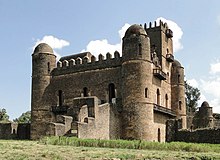
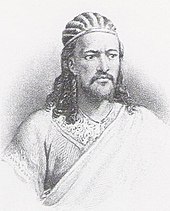
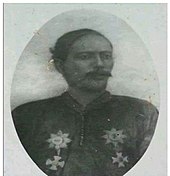


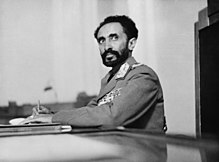

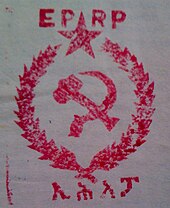
















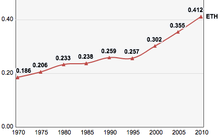
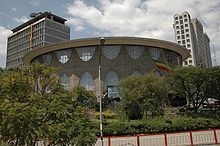






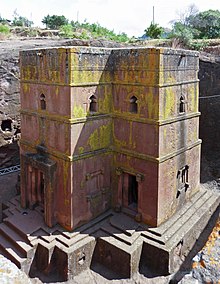

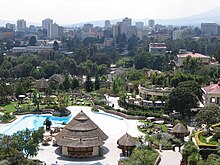







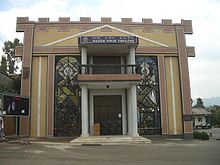
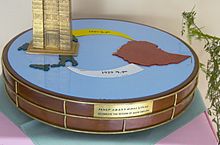
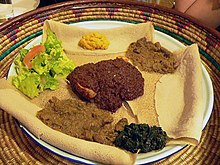

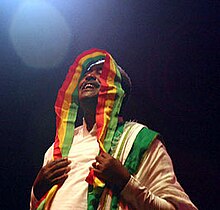










No comments:
Post a Comment